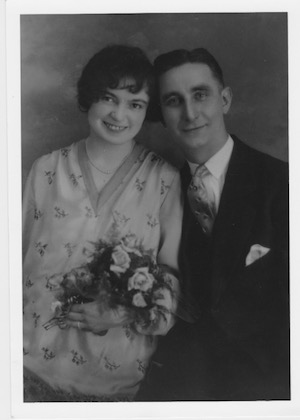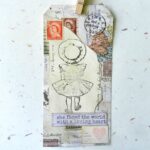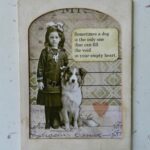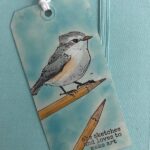Gertrude’s Story

I sat on the long, worn wooden bench trying to imagine what the big gray room would have been like on November 18, 1923 – the noise, the somber faces – and how nineteen-year-old Gertrude Glaser must have felt as she disembarked here at Ellis Island. I never asked her. Like so many grandchildren, I didn’t think much about it until it was too late to ask. My grandmother didn’t talk about her early life in Germany, so our family has very few details, but after a visit to Ellis Island with my aunt and cousins, I began thinking about Gertrude’s story and have finally pieced together her remarkable journey of perseverance and courage. I share it now to honor her during Women’s History Month.
My grandmother, Gertrude Elsie Glaser Brookman, was born in Zwickau, Germany in 1904, seventy six miles southwest of Dresden. Her family later moved to nearby Planitz, where she grew up with five brothers and three sisters.
When Gertrude was just 12 years old, her parents sent her to Russia to work in the potato fields, as there were just too many mouths to feed at home. Homesick and ill, young Gertrude soon returned to her family in Planitz. This happened during World War I and traveling must have been extremely difficult – and frightening. I do not know who, if anyone, accompanied her.
At age 19, she was sent off on another adventure – this time to America. She sailed on the Albert Ballin, departing from Hamburg. As thousands of immigrants before her, Gertrude stood with fellow passengers in the Registry Room to answer questions. On the ship’s manifest, her occupation is listed as housemaid and her sponsor, the Heintz family of Philadelphia.
Gertrude did not speak English, but was able to get a job in Philadelphia at a cigar factory, where she became quite ill from the smell. She then went to work for the Heintz family as a housekeeper. Not long after she began working for them, she was injured as she boarded the #41 trolley on 63rd street, whose tracks at that time ran down the center of the street. With one foot on the car and the other not yet there, a passing car caught her free leg and drug her for a distance. When she woke up in the hospital, she was terrified at the sight of policemen in her room. They may have reminded her of uniformed soldiers in her home country. She became so distraught and frightened, that she bit off part of her tongue. What a terrifying experience for young Gertrude.
While working for the Heintz’s, Gertrude met Harry Brookman, my grandfather, who was employed as a cake decorator at the Heintz bakery. The two married in 1927. Children followed – a son, Harry, in 1928 and twin daughters, Joan and Janet, in 1933. My grandfather became a well-known baker and cake artist in Philadelphia, and created the cake for the 1937 wedding of Franklin D. Roosevelt Jr. and Ethel DuPont.
Philadelphia had a large German population and for a time Gertrude and Harry socialized with other Germans in the area, but as World War II approached and then began, these associations quieted. The young family became a target of anti-German sentiment when their next-door neighbor painted swastikas on the front of their house. They later moved to Drexel Hill, where they lived for many years.
An accomplished seamstress, my grandmother developed a large clientele in the Philadelphia area. Her domain was the front room upstairs at the end of the hall, well lit by sunlight coming through several windows. The room’s décor came from stacks of colorful fabric (that my grandmother referred to as her “goods”) waiting to be chosen for a dress or skirt. Overflow goods were kept in the attic in shopping bags from iconic Philadelphia stores Strawbridge and Clothier, and Wanamaker’s. The whir of the sewing machine provided background music as Gertrude cut, pinned, and sewed. Even on a day with no customers, my grandmother had company in her little sewing kingdom with Judy, her wrought iron dress form, keeping watch over patterns, buttons, and fabric swatches from her post in the corner.
Harry and Gertrude celebrated their 50th wedding anniversary on April 16, 1977, with dozens of family members and friends singing, dancing, and enjoying themselves. The party served as a sweet sendoff, as my grandfather passed away the following day. Soon after he died, my grandmother studied and became an American citizen. Next, she obtained a passport and fulfilled another dream – to visit Germany and see her younger brother, Rudy, whom she had not seen in almost fifty years. So, at age seventy-four, off she went to Germany, an adventure that may have been as harrowing as the one that first brought her to America.
My grandmother had corresponded with her brother many years earlier, but that had stopped for some reason. Though she had written to Rudy several times about her planned visit, she had not received a reply. Not knowing if he would be there to meet her or even if he was alive, she made the trip to Zwickau anyway, hoping for the best. Zwickau, located in eastern Germany, was still under Russian control at the time of her visit. Along her route, the intrepid Gertrude often had to pay people (more uniforms) to allow her to continue on.
She must have been anxious and exhausted as she arrived in Zwickau, but at her long journey’s end she stepped off the train, looked around. . . and there was Rudy. What a joyous reunion they must have had! My grandmother’s courage had brought her full circle, back to where her story began in 1904.
Gertrude died in 1980. Her name, Gertrude Glaser Brookman, appears on the American Immigrant Wall of Honor at Ellis Island, panel number 739. I know she would be proud of that.
Judy, the sewing sentinel, is in my studio, watching over me as I write and paint. 
















